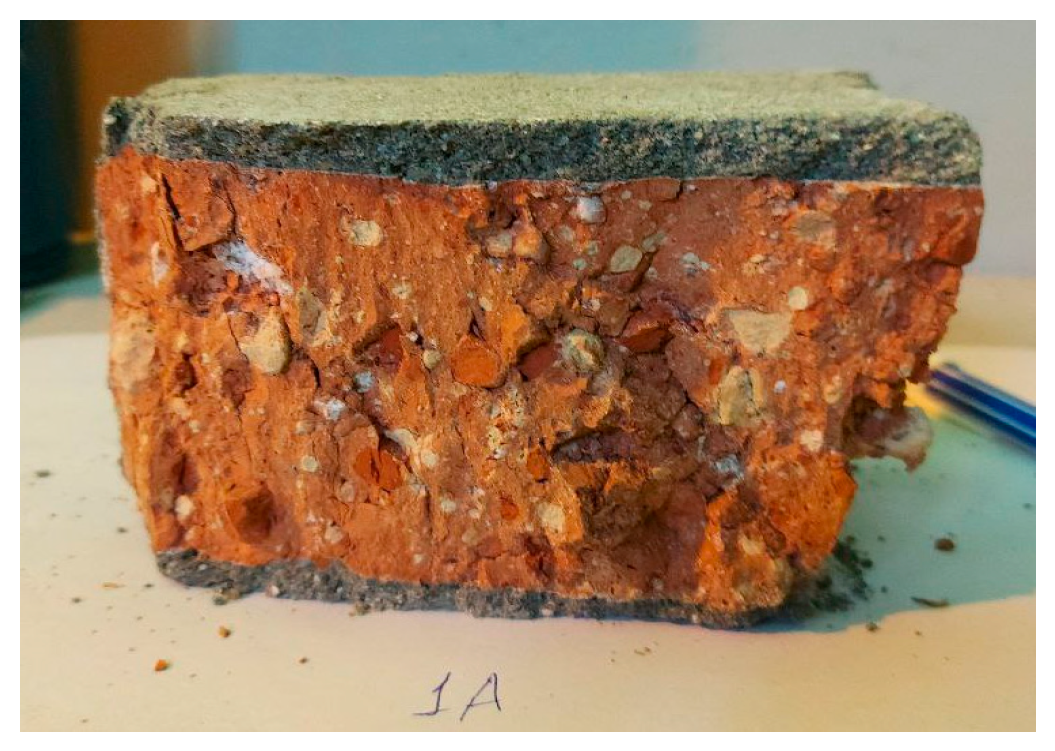1. Introduction
Clay brick elements have been used as a building material since ancient times. Despite several modifications of the clay brick uses, shape, and manufacture over thousands of years of constant evolution, the simplicity that made it successful remained. Numerous buildings built with clay bricks prevailed until the 21st century, which testifies to the strength of this material along centuries of rainstorms, snow, thaw-freezing cycles, high temperatures, and human-induced deterioration. Moreover, brick could be easily, inexpensively, and rapidly handled and produced with a simple manufacturing process. It is based on fired clay; a raw material available in large quantities all over the Earth. Its wide use proved that clay brick was an effective construction material that could provide both resistance to prevalent climatic conditions and insulation from cold and heat. It is known that the properties of ancient clay brick masonry rely essentially on the properties of the brick units, which depend on the quality of the raw materials used, together with the manufacturing process technology. The analysis of clay brick production and final properties are therefore fundamental. Generally, it is crucial to obtain information on the main physical, chemical and mechanical properties of clay bricks as well as the characteristics of the raw materials used and their manufacturing process. Solid clay brick lined with mortar were among the materials used in the construction of historical buildings. During the renovation of historical structure, the strength characteristics of masonry material must be known. This can be investigated either by destructive testing method, or the employment of non-destructive testing methods.
Destructive testing involves the removal of a sample from the structure and a small test sample extracted from the masonry (brick cutouts) [
1]. When determining the compressive strength for overall brick, the compression strength of a small masonry test specimen is multiplied by shape factors [
2].
For non-destructive testing it is necessary to have a calibration relationship between the parameter from non-destructive testing and real measured compressive strength [
3]. One of the most commonly used non-destructive testing methods is the rebound hammer test (Schmidt hammer test). Originally it was invented for concrete surface hardness measuring with characteristic curves for specific cube and cylindrical size elements [
4]. In the case of concrete, many test results have already been collected. The effect of different Schmidt hammers was investigated, and measurement uncertainties were also evaluated in detail. Eventually, researchers have shown that it can be applicable to the clay brick masonry [
1,
3,
5,
6,
7,
8,
9], but there are much less data available to practicing engineers on its use. Brozovsky quotes that Rebound hammer test can be used in practice for lime sand bricks but in the case of honeycomb bricks or hollow block elements special considerations need to be taken into account to obtain correlation between rebound number and compressive strength [
6]. While the surface area of concrete structures is large and uniform, where measurement locations can be easily marked, masonry units are relatively small. The size of the bricks means that only a limited number of measurements can be made on a single element. There is no general recommendation for the number of measurement points and their location within the element. If the recommendation for concrete blocks is applied, one to three points can be measured on a solid clay brick. Based on a specific calibration curve, the type-N Schmidt rebound hammer test on high quality solid clay brickwork shows that an estimate of the compressive strength within the confidential limit of ±25% can be obtained [
8].
The rebound hammer provides a quick, inexpensive means of estimation of compressive strength. However, studies have shown that rebound readings are sensitive to near-surface properties and influenced by surface smoothness, age of concrete, moisture content, carbonation, presence of aggregates, presence of air voids and steel reinforcement, temperature, and calibration of the rebound hammer [
1,
3,
4,
5,
6,
7,
8,
9].
Since clay brick strength depends on the brick properties, the mortar plays a minor role, and a low detailed and fast estimate of brickwork strength may be deduced from the bricks only [
8]. The study on the effect of the surface polishing, the height, width, and length of the clay specimens, the type of the sampling (drilled or cut), and the effect of the production technology using standard (destructive) compressive tests and Schmidt hammer (non-destructive) tests showed that the behavior of the brick is orthotropic and the effect of the height of the specimen has the most significant effect on the compressive strength [
9].
The solid clay brick, which is used in historical structures, has been exposed to the environment for a long time and the manufacturing method is also too old. This has its own impact on strength and product quality, respectively [
7]. To address this issue, accurately, the rebound hammer test result should be checked against the standard compression test results to validate the rebound hammer testing.
This research covers the important topic related to the clay brick such as the number of tests on one face element, the test location, and the need for modification in the calculation of average rebound value while evaluating the application of the Schmidt rebound hammer for the estimation of the compressive strength of solid clay brick elements. The aim is to lay down the foundation for correct calculation and interpretation of rebound value when determining compressive strength of historical clay brick. With this information, we can provide the static designer with essential data.




















